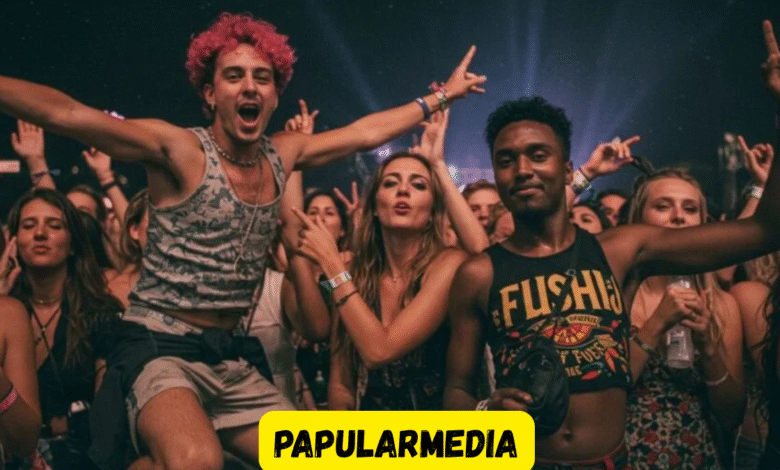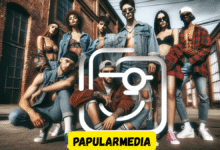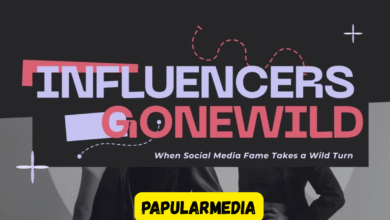Influencers Gonewild: A Deep Dive into the Viral Online Phenomenon

The Rise of Influencer Culture
Influencers Gonewild In the last decade, the digital age has birthed a new kind of celebrity—the influencer. Powered by social media platforms like Instagram, TikTok, Twitter, and YouTube, influencers have become central figures in shaping trends, sparking conversations, and building entire online communities. These individuals harness the power of content to attract large audiences, promoting everything from lifestyle and fashion to politics and wellness. However, with this immense popularity comes scrutiny, and occasionally, controversy. This leads us to the topic of “influencers gonewild,” a term that encapsulates the phenomenon of online personalities engaging in behavior that stuns, shocks, or scandalizes their followers.
What Does “Influencers Gonewild” Mean?
“Influencers gonewild” refers to situations in which social media influencers break away from expected norms or reputations and engage in erratic, controversial, or extreme behavior. While the phrase may initially sound salacious or dramatic, it is often used to describe a wide range of actions—from unexpected live-stream outbursts and personal meltdowns to leaked private content or offensive commentary. In many cases, such events spark intense online debates, generate viral media coverage, and sometimes even lead to loss of brand deals, followers, Influencers Gonewild or legal consequences.
The Internet’s Role in Amplifying Missteps
Social media, by its very design, rewards bold and shocking content. Platforms favor engagement, and nothing garners clicks, shares, and views faster than controversy. When influencers go off-script or act unpredictably, their content often travels rapidly across the web. Clips are reshared, comments flood in, and discussions erupt in forums and threads. While this visibility can momentarily elevate an influencer’s profile, it can also be the catalyst for a significant public backlash.
What distinguishes the “gonewild” aspect of influencers’ behavior is not just the act itself, but the virality it achieves. The internet has a way of turning private moments into public spectacles. One small clip, tweet, or image can snowball into a defining narrative for an influencer, often overshadowing years of carefully curated content.
Fame, Pressure, and the Breaking Point
One cannot ignore the immense pressure influencers face. Living under constant public gaze requires them to maintain a near-perfect persona, which is not only exhausting but unsustainable. Influencers are expected to be available 24/7, consistently creating content, engaging with fans, and staying on top of trends. This level of pressure, combined with the need to stay relevant, sometimes drives influencers to make impulsive decisions or act out in unexpected ways.
Moreover, the digital environment lacks boundaries. Audiences can demand more personal access, question motives, and criticize choices in real-time. This incessant exposure can lead to emotional burnout, mental health issues, and eventually, moments of breakdown or rebellion that characterize the “gonewild” tag.
The Allure of Shock Value
In some cases, influencers knowingly engage in controversial acts as a means to gain attention. In a saturated market where millions are vying for visibility, shock value becomes a marketing tool. Some influencers lean into drama or exaggerated personas, pushing the boundaries of taste or decency to provoke reactions. While this can momentarily skyrocket engagement, it often comes with long-term consequences—alienating followers, losing sponsorships, or being banned from platforms.
This performative chaos has become a trend in itself. Followers, desensitized to everyday content, crave novelty, and controversy offers exactly that. The cycle becomes self-perpetuating—controversy breeds attention, attention feeds the algorithm, and influencers benefit from the increased visibility, at least temporarily.
Public Backlash and Cancel Culture
A recurring theme within the “influencers gonewild” phenomenon is the swift backlash that often follows. Cancel culture has become a dominant force in digital society. When influencers are caught in a scandal—be it offensive remarks, insensitive jokes, or inappropriate behavior—audiences react quickly. Hashtags trend, apology videos are posted, and judgment is swift.
However, cancel culture is not always straightforward. While some influencers face serious consequences and disappear from the public eye, others bounce back, rebrand, or gain a new following. The internet has a short memory, and redemption arcs are not uncommon. Nonetheless, the experience often leaves lasting impacts on an influencer’s brand and psyche.
The Influence on Youth and Online Behavior
One of the more concerning aspects of influencers going off the rails is the impact it has on young audiences. Many fans of influencers are teenagers or young adults who view them as role models. When these figures engage in reckless or harmful behavior, it can send confusing signals to impressionable followers.
Moreover, the normalization of such behavior can lead to the belief that virality justifies the means. Young content creators might mimic these stunts in hopes of gaining attention, perpetuating a cycle of online extremity. It brings into question the responsibility influencers have toward their audiences, especially when their platforms carry so much sway.
The Role of Platforms in Curbing or Enabling Behavior
Social media platforms play a significant role in shaping influencer behavior. Their algorithms reward engagement regardless of whether it’s positive or negative. This incentive structure can unintentionally promote outrageous acts. Platforms have also been criticized for being slow to take action against problematic content, especially when it comes from high-profile users.
On the flip side, platforms have begun enforcing stricter guidelines and suspending accounts that cross ethical or legal boundaries. Still, questions linger about whether more proactive moderation is needed or if this becomes a form of censorship that stifles expression.
When Influencers Try to Reclaim Their Narrative
In the aftermath of a “gonewild” moment, many influencers try to reclaim their story. Apology videos, podcast interviews, public statements, and rebranding efforts become tools for damage control. Some succeed in turning the scandal into a learning moment, offering transparency and demonstrating personal growth.
Others, however, struggle to regain their credibility. The court of public opinion can be unforgiving, especially if the influencer’s actions were particularly egregious or repeated. The ability to recover often depends on the sincerity of the apology, the influencer’s past reputation, and the support of their fanbase.
The Blurred Line Between Authenticity and Strategy
Influencers are constantly navigating the delicate balance between being authentic and being strategic. Audiences crave genuine content, yet the influencer market rewards polished branding and strategic partnerships. When influencers “go wild,” the curtain often falls away, exposing their raw, unfiltered selves. While some fans find this refreshing, others feel betrayed, especially if it contradicts the influencer’s previous values or image.
Authenticity becomes a double-edged sword. Too much of it, particularly when unfiltered, can invite criticism. Too little of it can lead to accusations of being fake or manipulative. This tension is at the heart of many influencer controversies.
A Mirror of Modern Culture
The “influencers gonewild” phenomenon is not just about individual missteps; it reflects broader cultural shifts. It highlights society’s obsession with fame, the pressures of online visibility, and the consequences of living life publicly. Influencers are products of their environment, and their actions—good or bad—reveal much about the digital world we’ve built.
In a sense, these incidents act as cautionary tales. They show the fragility of internet fame, the volatility of public opinion, and the ever-thin line between admiration and condemnation. They also force audiences to confront their role in these dynamics—how quickly they praise, how harshly they judge, and how easily they forget.
Looking Ahead: The Future of Influencer Accountability
As influencer culture continues to evolve, so too must the systems that support or check it. From more robust platform policies to brand partnerships rooted in shared values, there’s a growing push for accountability. Influencers are being asked to be more transparent, more ethical, and more conscious of their influence.
At the same time, audiences are becoming savvier. They no longer blindly follow, instead demanding integrity, accountability, and substance. This shift could usher in a new era of content creation—one where fame is built not just on attention, but on trust.
Frequently Asked Questions
What does “influencers gonewild” actually refer to?
It describes moments when influencers engage in shocking, controversial, or unexpected behavior that grabs public attention, often leading to backlash or media frenzy.
Is “influencers gonewild” always negative?
Not always, but it usually carries a negative or scandalous connotation, especially when the influencer’s actions violate public expectations or platform guidelines.
Why do influencers act out or behave controversially?
Reasons vary—some face extreme pressure, mental health struggles, or burnout, while others deliberately seek attention through shock value. Fame and relevance are powerful motivators.
Can influencers recover from a “gonewild” moment?
Yes, many do. Recovery depends on the nature of the scandal, public perception, and how the influencer addresses the issue. Apologies, transparency, and rebranding often help.
How can audiences be more responsible consumers of influencer content?
Audiences should think critically, avoid sensationalism, and hold influencers accountable while also allowing space for growth and redemption. Supporting positive, authentic creators is also key.
Do platforms bear responsibility when influencers go off the rails?
Yes, to a degree. Platforms shape behavior through algorithms and moderation policies. They must balance free expression with accountability and community standards.
What impact does this trend have on younger audiences?
It can influence their behavior and expectations. Seeing influencers act out or go viral for negative reasons may normalize risky or controversial behavior, especially if there are no consequences.
How can influencers maintain authenticity without going to extremes?
By setting boundaries, focusing on meaningful engagement, prioritizing mental health, and staying grounded in their values, influencers can remain authentic without seeking shock value.
Is shock content always bad?
Not necessarily. Shock content can challenge norms Influencers Gonewild or start important conversations, but it becomes harmful when it’s rooted in manipulation, disrespect, or harmful stereotypes.
Will influencer scandals always be part of the digital landscape?
As long as fame, attention, and monetization are tied to engagement, there will be room for controversy. However, increasing audience awareness and demand for ethics may reduce its prevalence.




